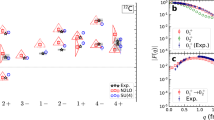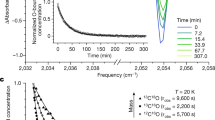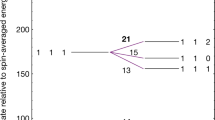Abstract
For decades, protonated methane, CH5+, has provided new surprises and challenges for both experimentalists and theoreticians. This is because of the correlated large-amplitude motion of its five protons around the carbon nucleus, which leads to so-called hydrogen scrambling and causes a fluxional molecular structure. Here, the infrared spectra of all its H/D isotopologues have been measured using the ‘Laser Induced Reactions’ technique. Their shapes are found to be extremely dissimilar and depend strongly on the level of deuteration (only CD5+ is similar to CH5+). All the spectra can be reproduced and assigned based on ab initio quantum simulations. The occupation of the topologically different sites by protons and deuterons is found to be strongly non-combinatorial and thus non-classical. This purely quantum-statistical effect implies a breaking of the classical symmetry of the site occupations induced by zero-point fluctuations, and this phenomenon is key to understanding the spectral changes studied here.
This is a preview of subscription content, access via your institution
Access options
Subscribe to this journal
Receive 12 print issues and online access
$259.00 per year
only $21.58 per issue
Buy this article
- Purchase on Springer Link
- Instant access to full article PDF
Prices may be subject to local taxes which are calculated during checkout



Similar content being viewed by others
References
Saykally, R. J. Infrared laser spectroscopy of molecular ions. Science 239, 157–161 (1988).
Scuseria, G. E. The elusive signature of CH5+. Nature 366, 512–513 (1993).
Boo, D. W., Liu, Z. F., Suits, A. G., Tse, J. S. & Lee, Y. T. Dynamics of carbonium ions solvated by molecular hydrogen: CH5+(H2)n (n = 1,2,3). Science 269, 57–59 (1995).
Marx, D. & Parrinello, M. Structural quantum effects and three-centre two-electron bonding in CH5+. Nature 375, 216–218 (1995).
White, E. T., Tang, J. & Oka, T. CH5+: The infrared spectrum observed. Science 284, 135–137 (1999).
Marx, D. & Parrinello, M. CH5+: The cheshire cat smiles. Science 284, 59–61 (1999).
Marx, D. & Parrinello, M. CH5+ stability and mass spectrometry (Response). Science 286, 1051a (1999); see www.sciencemag.org/cgi/content/full/286/5442/1051a.
Asvany, O. et al. Understanding the infrared spectrum of bare CH5+. Science 309, 1219–1222 (2005).
Borman, S. Protonated methane probed. Chem. Eng. News 83, 45–48 (2005).
Borman, S. Chemistry highlights 2005. Chem. Eng. News 83, 15–20 (2005).
Huang, X. et al. Quantum deconstruction of the infrared spectrum of CH5+. Science 311, 60–63 (2006).
Olah, G. A. & Rasul, G. From Kekulé's tetravalent methane to five-, six-, and seven-coordinate protonated methanes. Acc. Chem. Res. 30, 245–250 (1997).
Olah, G. A., Prakash, G. K. S. & Sommer, J. Superacids Ch. 3, 5 (Wiley, 1985).
Olah, G. A., Prakash, G. K. S., Williams, R. E., Field, L. D. & Wade, K. Hypercarbon Chemistry Ch. 1, 5, 7 (Wiley, 1987).
Oka, T. Infrared spectroscopy of carbo-ions. Phil. Trans. R. Soc. Lond. A 324, 81–95 (1988).
Herbst, E. Chemistry of star-forming regions. J. Phys. Chem. A 109, 4017–4029 (2005).
Gerlich, D. Probing the structure of CH5+ ions and deuterated variants via collisions. Phys. Chem. Chem. Phys. 7, 1583–1591 (2005).
Kumar, P. P. & Marx, D. Understanding hydrogen scrambling and infrared spectrum of bare CH5+ based on ab initio simulations. Phys. Chem. Chem. Phys. 8, 573–586 (2006).
Schlemmer, S., Lescop, E., von Richthofen, J., Gerlich, D. & Smith, M. A. Laser induced reactions in a 22-pole ion trap: C2H2+ + hν3 + H2 → C2H3+ + H. J. Chem. Phys. 117, 2068–2075 (2002).
Schlemmer, S. & Asvany, O. Laser induced reactions in a 22-pole ion trap. J. Phys.: Conf. Series 4, 134–141 (2005).
Marx, D. & Hutter, J. Ab Initio Molecular Dynamics: Basic Theory and Advanced Methods (Cambridge Univ. Press, 2009).
Wilson, E. B. Jr, Decius, J. C. & Cross, P. C. Molecular Vibrations: The Theory of Infrared and Raman Vibrational Spectra (McGraw-Hill, 1955).
Wolfsberg, M. Isotope effects. Annu. Rev. Phys. Chem. 20, 449–478 (1969).
Dyczmons, V. & Kutzelnigg, W. Ab initio calculations of small hydrides including electron correlation XII. The ions CH5+ and CH5−. Theoret. Chim. Acta (Berlin) 33, 239–247 (1974).
Schreiner, P. R., Kim, S.-J., Schaefer, H. F. III & von Ragué Schleyer, P. CH5+: The never-ending story or the final word? J. Chem. Phys. 99, 3716–3720 (1993).
Marx, D. & Savin, A. Topological bifurcation analysis: Electronic structure of CH5+. Angew. Chem. Int. Ed. Engl. 36, 2077–2080 (1997).
Müller, H., Kutzelnigg, W., Noga, J. & Klopper, W. CH5+: The story goes on. An explicitly correlated coupled-cluster study. J. Chem. Phys. 106, 1863–1869 (1997).
Deskevich, M. P., McCoy, A. B., Hutson, J. M. & Nesbitt, D. J. Large-amplitude quantum mechanics in polyatomic hydrides. II. A particle-on-a-sphere model for XHn (n = 4,5). J. Chem. Phys. 128, 094306 (2008).
McCoy, A. B. et al. Ab initio diffusion Monte Carlo calculations of the quantum behavior of CH5+ in full dimensionality. J. Phys. Chem. A 108, 4991–4994 (2004).
Huang, X., Johnson, L. M., Bowman, J. M. & McCoy, A. B. Deuteration effects on the structure and infrared spectrum of CH5+. J. Am. Chem. Soc. 128, 3478–3479 (2006).
Johnson, L. M. & McCoy, A. B. Evolution of structure in CH5+ and its deuterated analogues. J. Phys. Chem. A 110, 8213–8220 (2006).
Asvany, O. et al. High-resolution rotational spectroscopy in a cold ion trap: H2D+ and D2H+. Phys. Rev. Lett. 100, 233004 (2008).
Oepts, D., van der Meer, A. F. G. & van Amersfoort, P. W. The free-electron-laser user facility Felix . Infrared Phys. Technol. 36, 297–308 (1995).
Marx, D. & Hutter, J. Modern Methods and Algorithms of Quantum Chemistry (ed. Grotendorst, J.) 301–449 (NIC, FZ Jülich, 2000).
Hutter, J. et al. CPMD Software Package, see www.cpmd.org.
Acknowledgements
The Bochum group is grateful to H. Forbert for useful discussions and technical help and is supported by Deutsche Forschungsgemeinschaft (DFG) (Normalverfahren MA 1547/4) and Fonds der Chemischen Industrie (FCI) (Chemiefonds–Stipendium to A.W. and general grant to D.M.). The simulations were carried out at HLRB II (München), Bovilab@RUB (Bochum) and Rechnerverbund–NRW (Dortmund). The Köln group gratefully acknowledges the help of their mechanical workshop (J. Krause, D. Moratschke and their team) as well as FOM for providing beam time. The skilful assistance provided by the Felix staff is greatly appreciated. Financial support by DFG through SFB 494 and the European QUASAAR network and the Initiative ‘Integrating Activity on Synchrotron and Free Electron Laser Science’ is also acknowledged.
Author information
Authors and Affiliations
Contributions
D.M. and S.S. designed the research. O.A., E.H., B.R. and S.S. performed the experiments. S.D.I. and A.W. performed the calculations. S.D.I., O.A., A.W., G.M., D.M. and S.S. analysed the data. S.D.I., O.A., A.W., D.M. and S.S. wrote the paper.
Corresponding authors
Ethics declarations
Competing interests
The authors declare no competing financial interests.
Supplementary information
Supplementary information
Supplementary information (PDF 1542 kb)
Rights and permissions
About this article
Cite this article
Ivanov, S., Asvany, O., Witt, A. et al. Quantum-induced symmetry breaking explains infrared spectra of CH5+ isotopologues. Nature Chem 2, 298–302 (2010). https://doi.org/10.1038/nchem.574
Received:
Accepted:
Published:
Issue Date:
DOI: https://doi.org/10.1038/nchem.574
This article is cited by
-
About the structure of CH5 + and structural variations in related systems
Structural Chemistry (2017)
-
COLTRAP: a 22-pole ion trapping machine for spectroscopy at 4 K
Applied Physics B (2014)
-
The two-component quantum theory of atoms in molecules (TC-QTAIM): the unified theory of localization/delocalization of electrons, nuclei, and exotic elementary particles
Theoretical Chemistry Accounts (2013)
-
Current trends in the development of A. M. Butlerov’s theory of chemical structure
Russian Chemical Bulletin (2012)
-
Interplay of thermochemistry and Structural Chemistry, the journal (volume 20, 2009) and the discipline
Structural Chemistry (2010)



